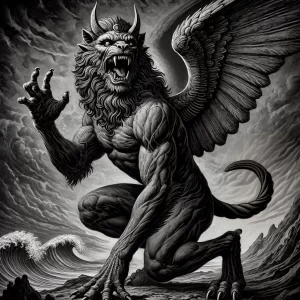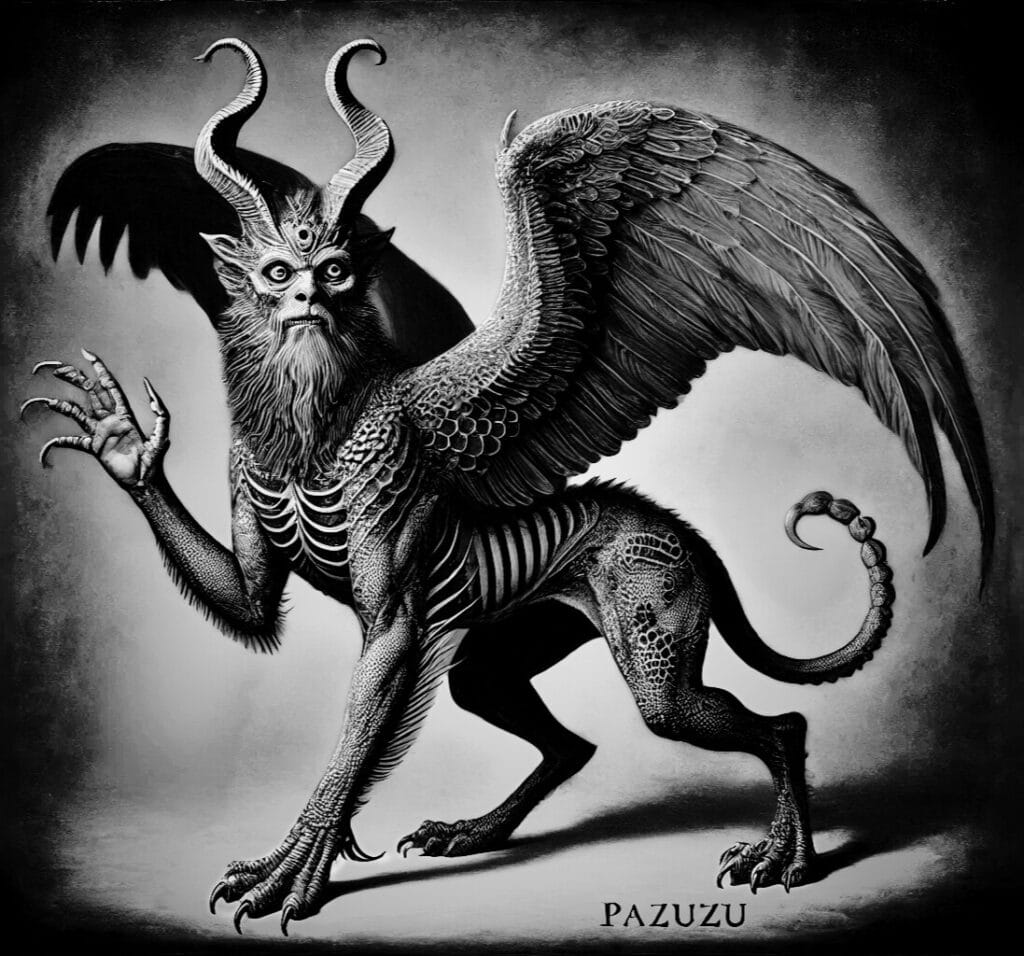A prominent figure in Mesopotamian mythology, Pazuzu is renowned as the ruler of the wind demons. He is an important figure in the myths of the Sumerians, Akkadians, Babylonians, and Assyrians, and he originated in ancient Mesopotamia (present-day Iraq). Although Pazuzu is frequently portrayed as a strong and terrifying demon, his function in ancient writings and amulets presents a more nuanced picture.
The Origins of Pazuzu
Mesopotamia, which includes sections of Iran, Syria, and Turkey in addition to present-day Iraq, is where Pazuzu first appeared. Dating back to the first millennium BCE, Pazuzu was primarily recognized in Assyrian and Babylonian mythologies. He is the son of Hanbi, another figure in the demonological hierarchy of the time.
Physical Depiction
Pazuzu is often depicted with a blend of animalistic and human characteristics:
- Human body with scales.
- Lion or dog-like face with sharp teeth.
- Eagle’s talons for feet.
- Wings of a bird.
- Scorpion’s tail.
These features symbolize his dominion over various elements of the natural and supernatural worlds.
Iconography
Eckart Frahm’s research indicates that Pazuzu’s appearance has stayed rather consistent over the course of his life. Pazuzu is portrayed as a blend of various human and animal components. With two pairs of wings, a scorpion’s tail, a serpentine penis, and avian talons for feet, his canine body is scaled rather than furred. He raises his right hand and lowers his left. Gazelle’s horns, human ears, a dog-like nose, bulging eyes, and cheek wrinkles make up his remarkable visage.
Role and Attributes
Pazuzu is primarily associated with the southwest wind, which brought famine during dry seasons and locusts during rainy seasons. He was described as a harbinger of chaos since he was seen as the embodiment of these destructive energies. But unlike a lot of demons with only evil characteristics, Pazuzu had two sides.
Despite his fearsome attributes, Pazuzu was invoked for protection against other evil spirits, particularly the demoness Lamashtu, who was believed to harm mothers and infants. Pazuzu’s ferocity made him an ideal guardian against such threats. Pregnant women so frequently employed old amulets and talismans with images of Pazuzu to ward off Lamashtu’s malevolent intents.
Symbolism and Protective Role
Pazuzu’s protective symbolism is unique in Mesopotamian mythology. Because of his tremendous control over destructive powers, he was both feared and revered. Pazuzu amulets usually showed him standing with one hand up, indicating his power and capacity to ward off bad spirits. Such amulets were often placed in homes or worn as jewelry to invoke his protective influence.
Pazuzu’s role as a guardian against Lamashtu highlights a key aspect of ancient Mesopotamian beliefs: the idea that evil forces could be countered by enlisting the aid of another powerful entity. This duality reflects the complexity of ancient demonology, where figures like Pazuzu could be both feared and revered depending on the circumstances.

Pazuzu in Modern Culture
Although Pazuzu was summoned for protection by the ancient Mesopotamians, his image has become increasingly evil in modern times. Pazuzu’s portrayal as an evil demon that possesses the child protagonist in the 1973 film The Exorcist is among his most famous appearances in popular culture. This interpretation, while fictional, has cemented Pazuzu’s image as a demon of great power and darkness in the popular imagination.
It’s crucial to keep in mind that Pazuzu’s significance in Mesopotamian culture was more complex than this contemporary depiction suggests. The intricacy of ancient beliefs about supernatural powers is demonstrated by his dual status as a protector against bad spirits and a bringer of plagues.
Pazuzu’s Influence on Mesopotamian Mythology
The impact of Pazuzu goes beyond his explicit representations and evocations. His persona illuminates the wider Mesopotamian perception of demons and their social functions. Demons were not inherently bad; rather, they stood for notions or natural forces that could be subdued or controlled to preserve the harmony of the cosmos.
In this sense, Pazuzu’s duality reflects the traditional view of good and evil as interdependent forces that must be balanced by one another. This viewpoint provides important context for understanding how ancient Mesopotamians viewed and engaged with their environment, especially the natural elements they revered and dreaded.
Conclusion
Pazuzu remains one of the most fascinating and enigmatic figures in Mesopotamian mythology. The fact that he is shown as a powerful demon with protective powers challenges the modern notion of demons as solely evil creatures. In ancient Mesopotamia, Pazuzu was a powerful emblem of the dual nature of life itself and was employed to fend off bad spirits.
References
- Black, Jeremy, and Anthony Green. Gods, Demons and Symbols of Ancient Mesopotamia: An Illustrated Dictionary. University of Texas Press, 1992.
- Collon, Dominique. Ancient Near Eastern Art. University of California Press, 1995.
- Finkel, Irving L. The First Ghosts: Most Ancient of Legacies. Hodder & Stoughton, 2021.
- Heeßel, Nils P. Lamashtu: An Edition of the Canonical Series of Lamashtu Incantations and Rituals and Related Texts from the Second and First Millennia B.C. Brill, 2002.
- Wiggermann, Frans A. M. Mesopotamian Protective Spirits: The Ritual Texts. Brill, 1992.
